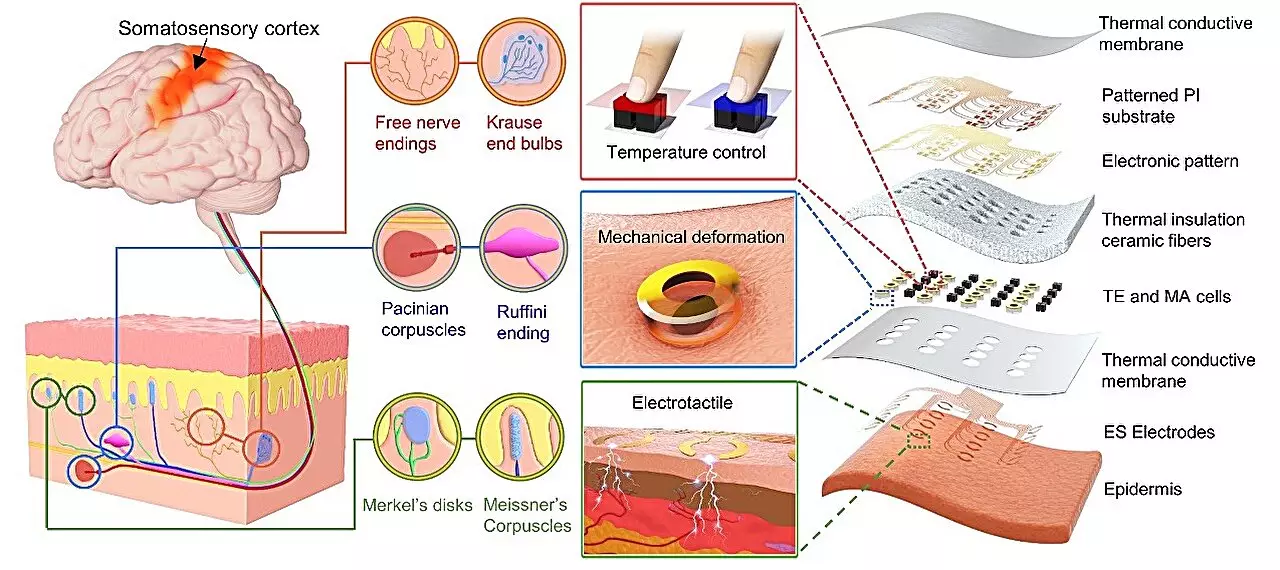Virtual reality (VR) and augmented reality (AR) technologies have come a long way in recent years, revolutionizing gaming and entertainment experiences. However, there is still ample opportunity for improvement, particularly when it comes to engaging the sense of touch. Researchers at the City University of Hong Kong and other institutes in China have been working on the development of new haptic interfaces that aim to provide users with realistic tactile sensations in virtual environments. Their recent publication in Nature Electronics introduces a groundbreaking haptic interface that delivers multi-dimensional tactile signals directly on the skin, promising to enhance virtual experiences like never before.
The Need for Tactile Feedback
While existing VR and AR technologies primarily focus on visual and auditory experiences, the sense of touch has been largely neglected. Prof. Xinge Yu, together with his research group, recognized this gap and began developing haptic feedback solutions based on flexible electronics. In a Nature Machine Intelligence publication in 2022, they introduced a wireless electrostimulation haptic interface that aimed to provide overall haptic feedback. However, their latest work goes beyond that by focusing on generating diverse immersive tactile sensations.
The human body is capable of perceiving a wide range of tactile information when interacting with different objects and surfaces. To replicate this in virtual environments, the research team developed a haptic interface that selectively stimulates various receptors, producing tactile sensations corresponding to different textures. This multidimensional approach mimics the complex signals the human body receives naturally, allowing for more realistic and immersive experiences in VR/AR.
Bridging Electrical and Mechanical Stimulation
Existing haptic feedback technologies can be categorized into two main approaches: electrical stimulation and mechanical actuation. Electrical stimulation focuses on activating nerves to generate actual tactile sensations within the body, while mechanical actuation replicates the skin’s deformation when interacting with physical objects. The challenge lies in accurately mimicking the tactile experience in both cases. The researchers’ breakthrough lies in bridging these two approaches, combining the advantages of electrical stimulation and mechanical actuation to achieve more diverse and immersive tactile feedback effects.
The team’s innovative haptic interface integrates three distinct feedback modes into a single skin-integrated device. By selectively stimulating different touch receptors based on their distribution and activation in the human body, the researchers have successfully created a platform for delivering highly realistic tactile sensations. This integration of multiple feedback modes opens new possibilities for providing users with richer and more immersive touch experiences in virtual environments.
The skin-integrated multimodal haptic interface developed by the research team is a significant contribution to the field of haptic technology. It not only enhances VR experiences but also opens the door to highly immersive VR content accompanied by realistic tactile sensations. As the research continues, there is still much room for development in the field of haptic feedback. Material synthesis, mechanical structure optimization, and neuro electrophysiology are just a few areas intertwined with the design and fabrication of feedback interfaces that hold potential for further advancements.
The advancement of virtual reality hinges on the ability to engage multiple senses, including touch. The exciting work carried out by the researchers at the City University of Hong Kong presents a major leap forward in haptic technology. By developing a haptic interface that delivers multi-dimensional tactile signals directly on the skin, they have paved the way for more immersive and realistic VR experiences. As the field of haptic feedback continues to evolve, we can expect to see a new era of virtual reality where tactile sensations play a central role in creating truly immersive digital worlds.



Leave a Reply